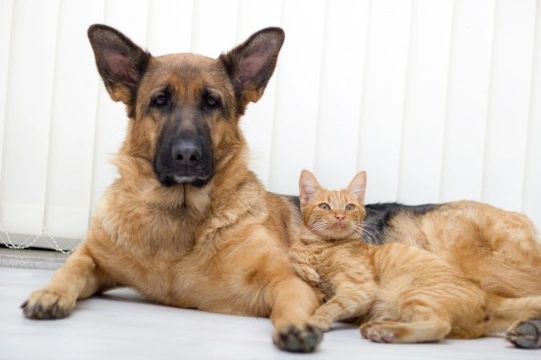Pets
Pets for studWanted petsBreedersAccessories & services
Knowledge hub
Support
Support & safety portal
Can Cats and Dogs Bond Together
While traditionally cats and dogs are thought to be enemies of old, and in the wild it is certainly true that many dog breeds would view cats as potential prey, it is entirely possible for cats and dogs to not only live together peacefully, but also potentially bond strongly too!
There is no real way to predict whether any given dog and cat will bond and actively enjoy each other’s company and become firm friends, but it should be possible for a cat and a dog to live together peacefully, particularly if they are homed together when young.
If you are not sure about how viable it is to create a happy relationship between a cat and a dog in your own home, or if you are wondering about how best to enable their bonding, read on to find out more.
Which came first, the cat or the dog?
While it is entirely possible to potentially bring a cat or kitten into the home of an existing resident dog, studies show that in order for a bond between cat and dog to have the best chance of success, the cat should be the first household resident. However, if your dog is already used to cats and you later take on a cat that is also used to dogs, the transition need not be hard then either.
The younger that the cat and dog are, the better chance they stand of accepting each other and seeing each other as allies; a kitten and a puppy are much more likely to get on and bond than a strange adult cat with a strange adult dog!
Below the age of one year old, both puppies and kittens are much more open to learning and better able to pick up on the differences between their behaviours and body languages, and to get used to the actions and reactions of the other party. After one year of age, cats have learned to be cats and dogs have learned to be dogs, and are likely to find it a little harder to understand each other, and “speak each other’s language,” as it were.
Introductions
Regardless of the age and background of either the cat or the dog, how their initial meeting is managed and how they are supervised together while they get used to each other can make a huge difference to how well things work out in the end!
Each pet should have their own room or zone of the house that the other party cannot enter, and meetings should be conducted slowly and carefully, well supervised and in a neutral part of the home. Both cat and dog should have the freedom to retreat from the other if they wish to, and go back into their own safe space.
Introductions and meetings can be made easier by getting the cat and dog used to each other’s scent before they meet, by transferring bedding and toys between the two pets so that they do not see each other’s smell as alien when they first meet.
For the initial introductions, keep the dog or puppy on a lead, or keep a baby gate between the two animals so that they can see and smell each other without coming into direct contact.
Older cats and dogs
While young puppies and kittens are likely to bond more easily and closely than their adult counterparts, forging a bond between two adult pets is by no means impossible! A large part of this will depend on the temperament of the dog and their natural prey drive, which is instinctively stronger in some breeds than others. Sighthounds and other hunting dogs are likely to prove challenging to train to accept cats unless trained from a very young age, while some other breeds will not automatically see the cat as prey!
Again, if a cat is used to dogs, they are much less likely to be afraid of them on sight, and even worse, to turn tail and run. If the cat runs , even dogs that in other circumstances would be fine may find that the drive to chase becomes overwhelming, reinforcing the cat’s fear and upsetting both animals!
Small dogs are often the best pick as friends for cats, as their similarity in size means they will be less likely to take on the cat! However, some very large breeds are incredibly calm, kind and gentle, and will also make friends with even the smallest of kitties!
Space and time
It is important not to rush the bonding and introduction process between a cat and a dog, and to let both pets go about things at their own pace.
The cat must have a safe room and space of their own, not only to physically get away to but also so that they can have their bed, food, toys and litter tray away from the dog, and never feel threatened or put out of place by the dog. While understandably a dog can generally do much more potential harm to a cat than a cat can do to a dog, do not forget that your cat might potentially swipe at or scratch the dog too, and plenty of dogs are rather wary of, or at least have a healthy respect for cats! Keep your cat safe at all times, but do not allow the cat to beat the dog up either!



